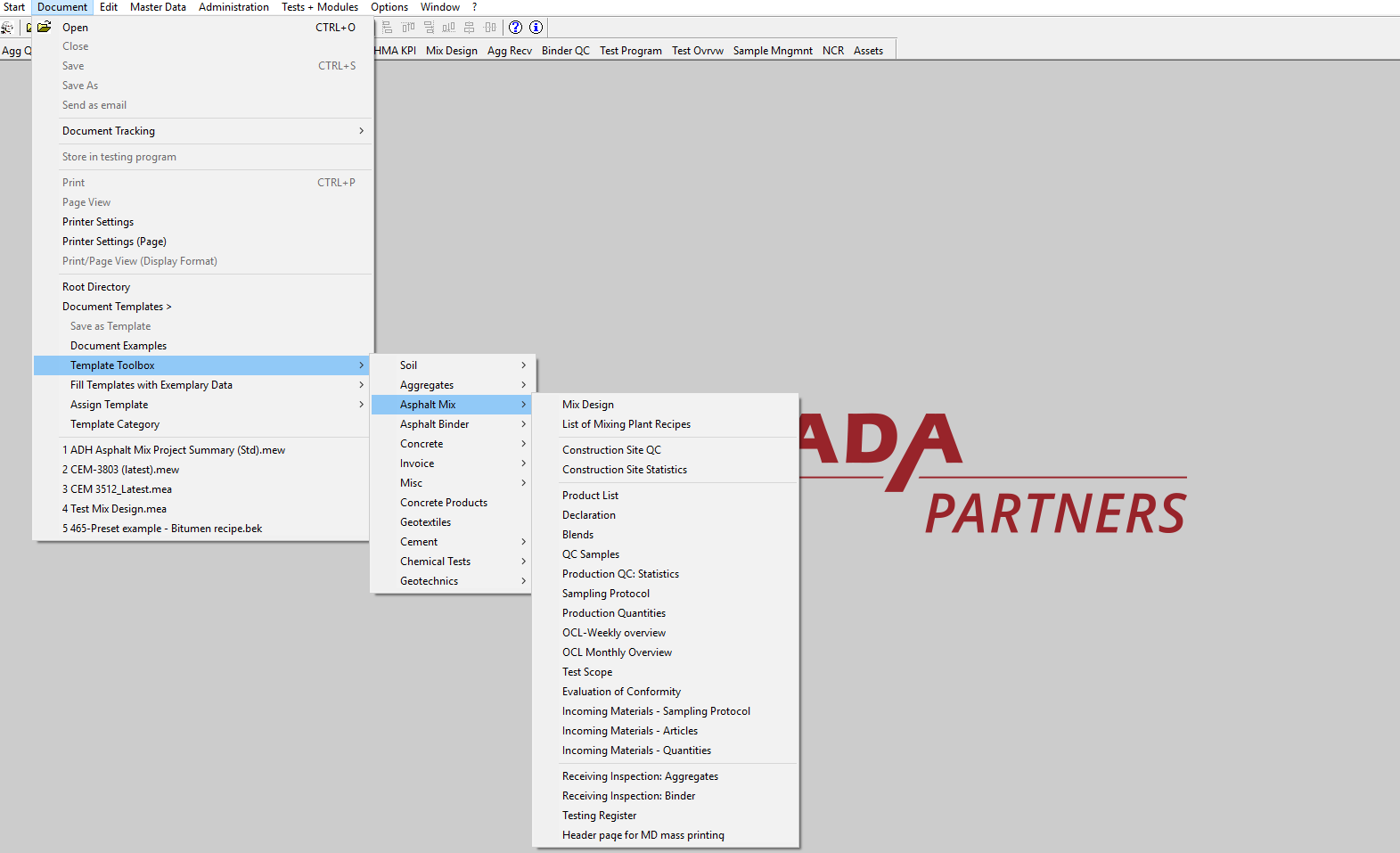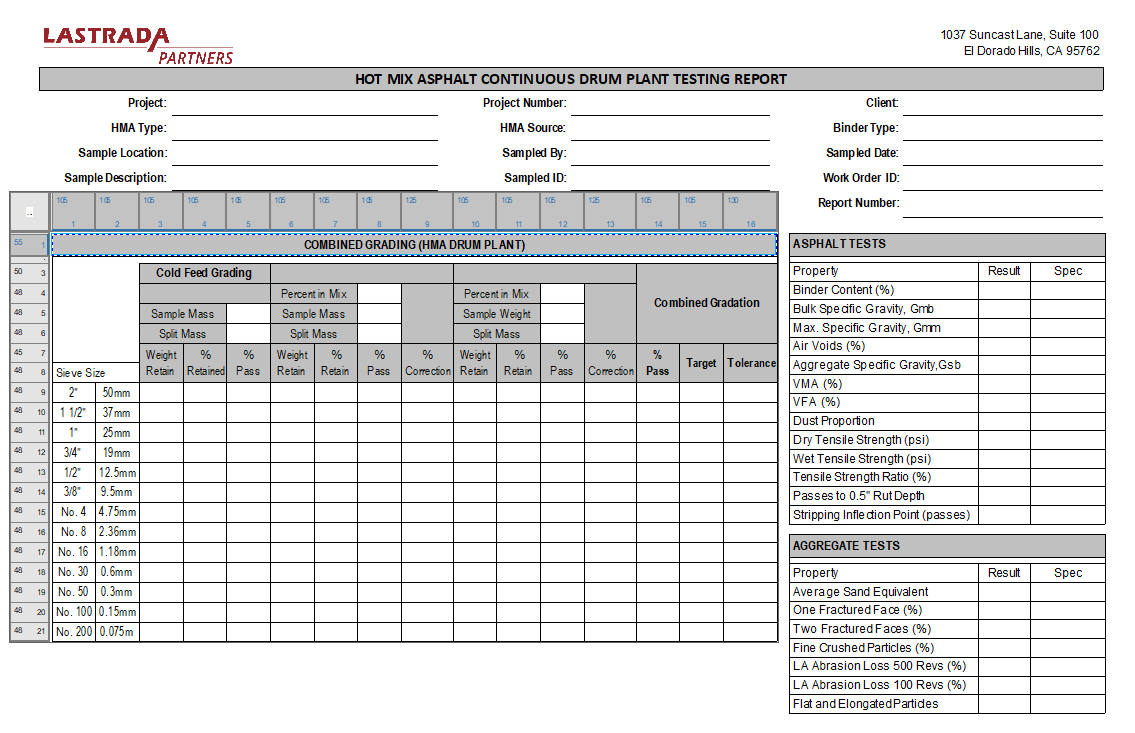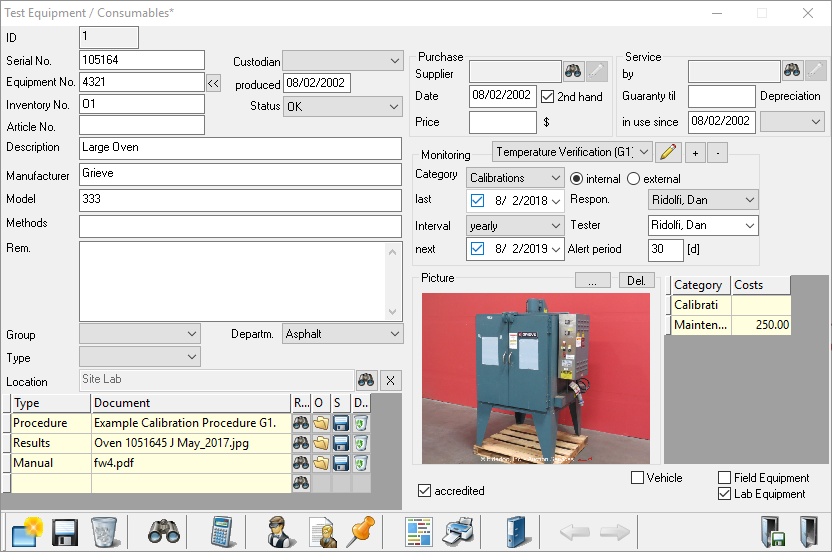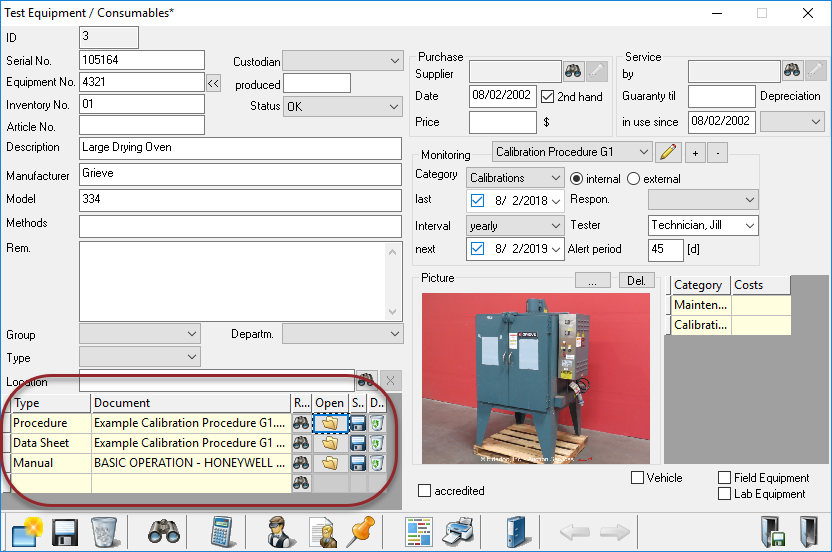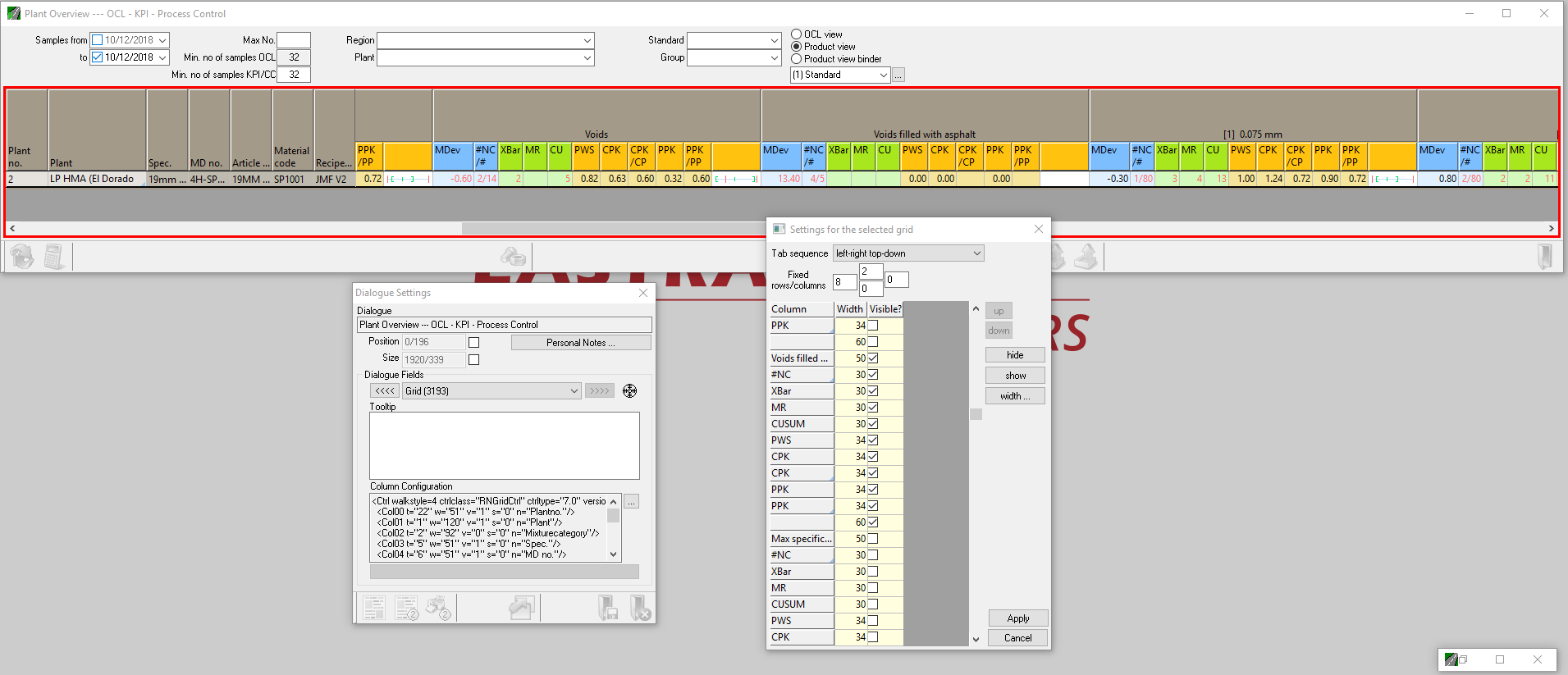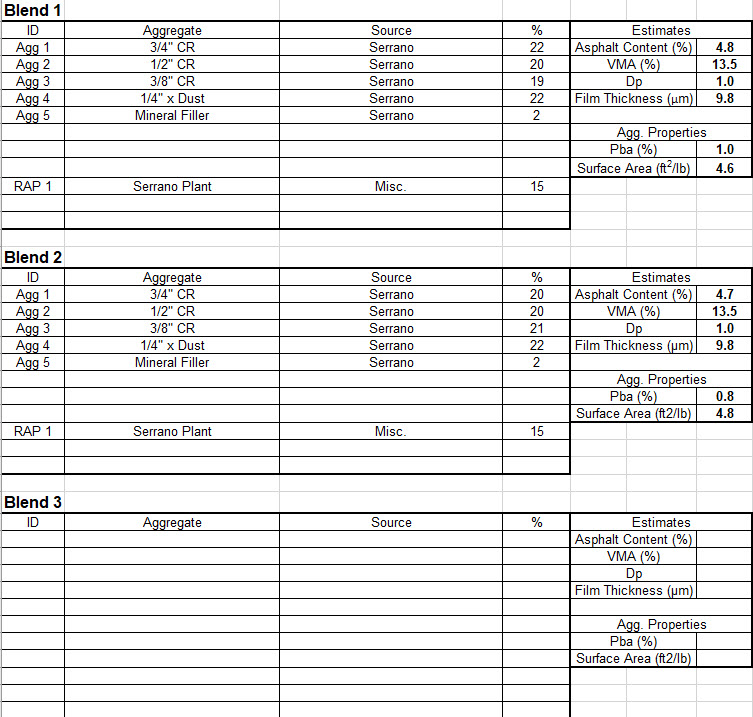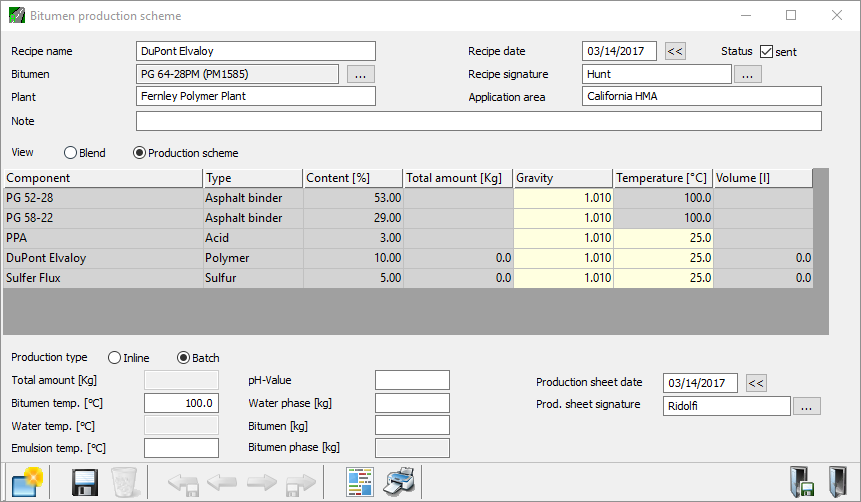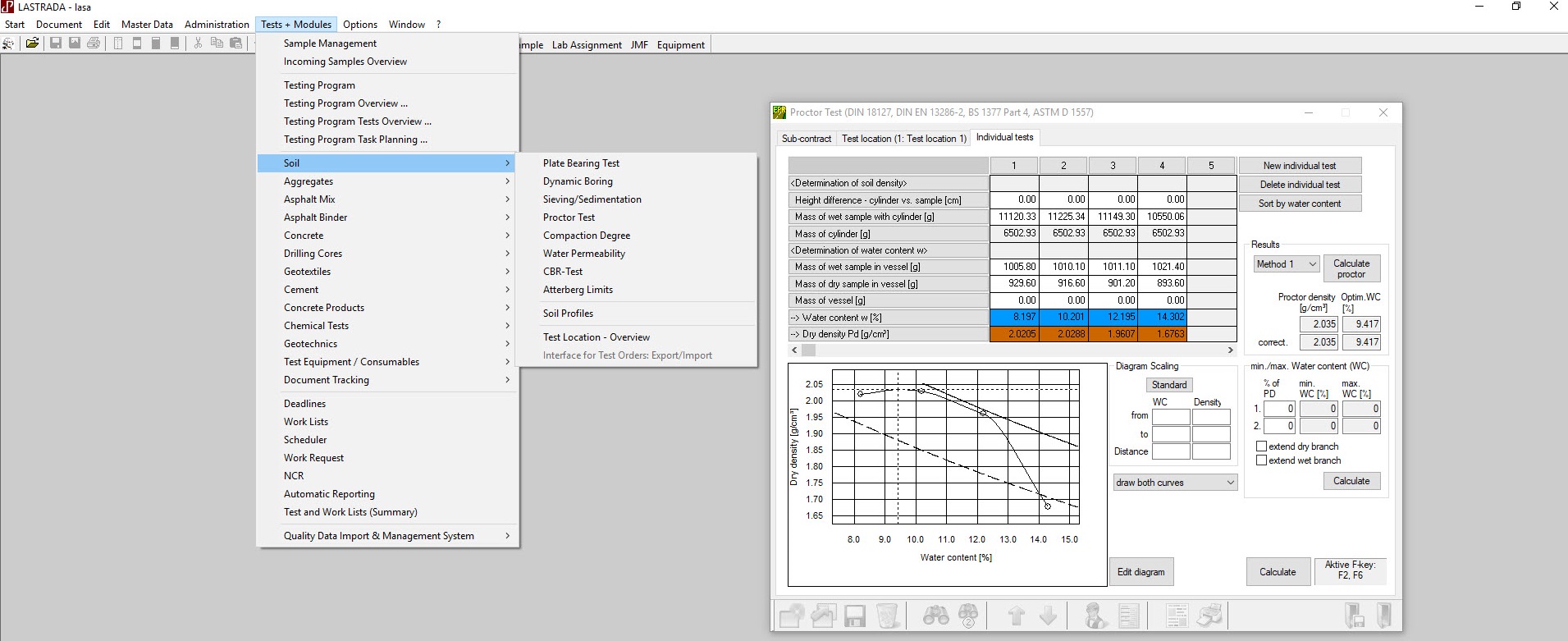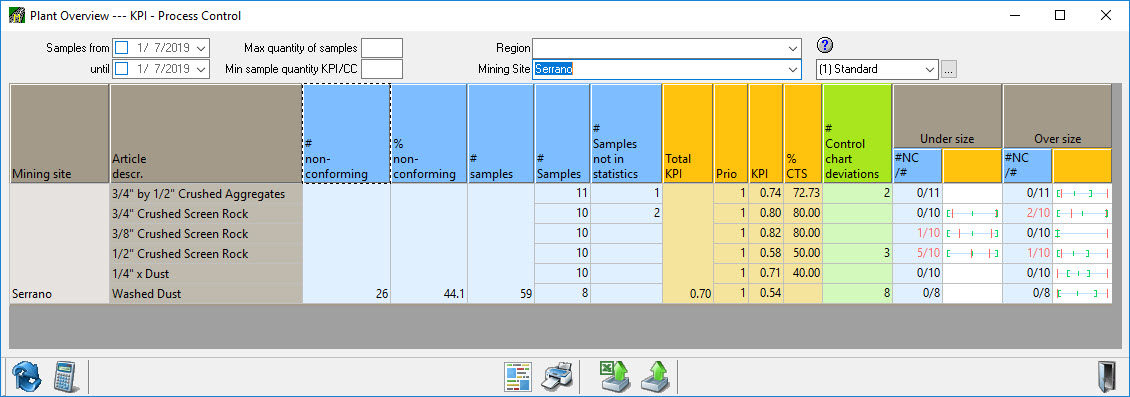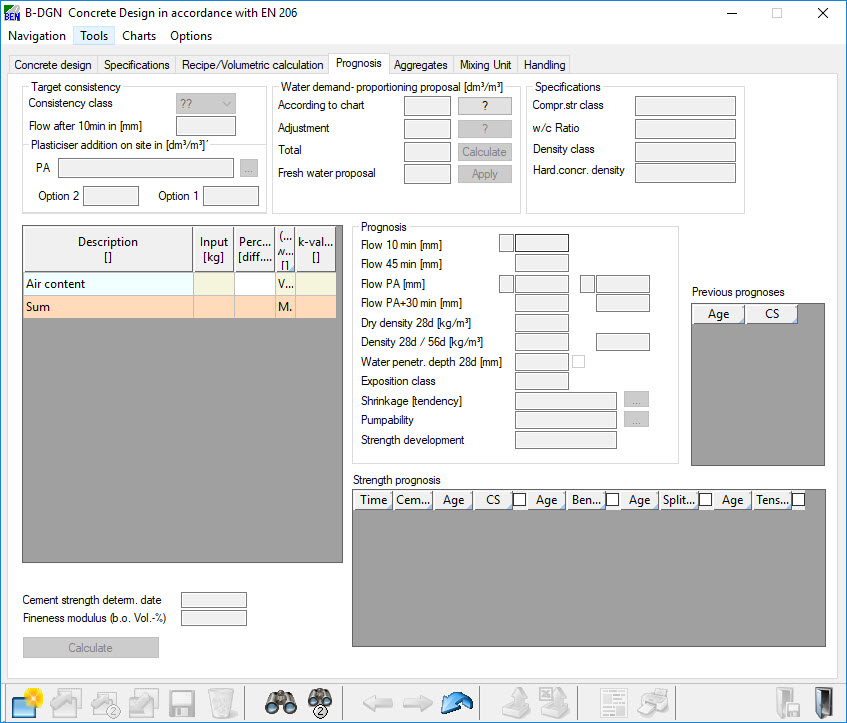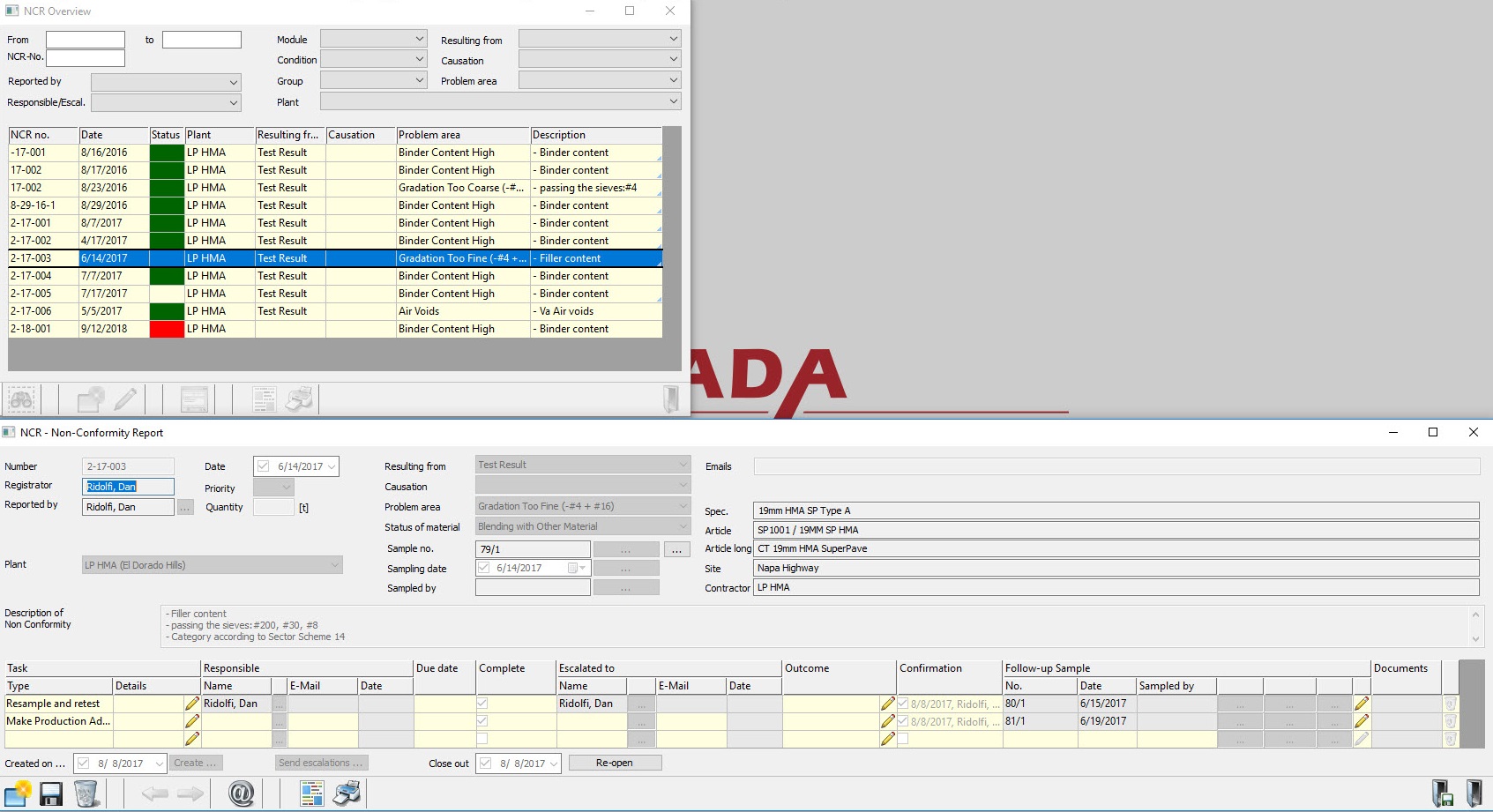LASTRADA™ construction materials testing software includes tools and modules to aid any organization in improving the quality of their materials. With an ever-evolving, easy to use platform and an extensive list of automations and integrations, work products are improved and costs are reduced. LASTRADA supports the custom workflows of asphalt, aggregate, binder, and concrete plants and testing labs throughout North America.
LASTRADA™: Construction Materials Testing Software
What’s inside? Browse the guide’s content below before taking it with you.
Features and Benefits – LASTRADA™: Construction Materials Testing Software
LASTRADA integrates construction materials testing, mix design, quality management, and management of laboratory processes simultaneously in one system. While supporting the latest standards, LASTRADA meets all information management demands company-wide, whether in the lab or on-site.
Simple & Efficient Data Entry
Whether installed locally, or accessed online, LASTRADA is designed to be both flexible and easy to use. This helps the people using the software daily embrace LASTRADA, because it makes their job easier.
LASTRADA is structured according to the actual laboratory workflow of hundreds of organizations. This gives it the ability to be integrated into any working environment. For example, master data is entered once. Because it is stored in a central database, it is available for all LASTRADA modules and workstations. User interfaces are simple and customizable. This makes the entry of data intuitive, as well as easy to use. LASTRADA modules are also self-contained, providing users with an intuitive approach to data entry.
Experienced LASTRADA users leverage the many secure and fast ways LASTRADA interfaces with almost all major software products. Some of these include SAP, Oracle, Datev, sageKHK, etc.

Immediate Savings and Long-Term Transformation
LASTRADA will immediately make an organization more efficient in gathering and reporting data and managing their quality operations. The software provides the tools for convenient and efficient working. As a result, employees are enabled to concentrate on monitoring quality instead of spending time on data transfer, error detection, and report writing. LASTRADA is delivered with a reporting platform, including a report template library. This library satisfies a broad array of needs with report template layouts.
LASTRADA users can easily refine reports to meet the demands of any organization or owner, or to quickly make a new report from scratch.
LASTRADA’s sample inventory management, testing registers, and scheduling features help manage a large number of projects. Information about all products, samples, designs, plants, projects, sites, clients, and equipment is always at your fingertips.
Materials producers will experience ongoing product quality improvements as their gathered data is leveraged using the analytics tools in LASTRADA. Construction materials testing labs continually improve their report delivery speed through deeper integration of LASTRADA into their processes. They also have the option to provide engineering analysis for their customers using the same analytics tools utilized by producers.
Cutting-Edge Information
LASTRADA provides extensive statistics and tools that keep you in touch with the latest facts and figures in the laboratory.
Those in charge of quality management have central access to product quality history and trends across all the company’s laboratories. Procedures for factory production control, receiving inspection, and type testing are integrated, as is quality data.
A special browser-based access provides key information in graphs and numbers for operations management and sales departments.
Variable search tools and summaries facilitate the evaluation of conformity and the localization of trends.
Unique Data Structure Utilizing Product Declarations
LASTRADA is the only QC construction materials testing software that organizes quality data around the concept of a product declaration. A declaration is being introduced to the construction materials industry in the form of an environment product declaration (EPD). The concept of a product declaration has been part of LASTRADA for over a decade.
The declaration and associated data structure yield tremendous value for LASTRADA users. Declarations help material producers and construction materials testing labs maintain a clear link between quality data, material submittals, production stockpiles, load out stock piles, asphalt mix designs, concrete mix designs, plant settings, asphalt binder properties, Portland Cement properties, chemical additive properties and the interrelation between them all.
Several Support Options
In addition to traditional support options, we offer an extensive knowledgebase with help videos, training guides, and a report template library that you can access online.
The engineers at LASTRADA Partners come from industry, so they can help you identify the ideal configuration to support your business. LASTRADA Partners has made our customers’ ideas a reality by co-developing engineering processes in LASTRADA. If you simply need another opinion, LASTRADA Partners is available to help trouble shoot quality issues or make process improvement recommendations.
The materials engineers at LASTRADA Partners work closely with the LASTRADA development team to add customer requests into LASTRADA. In addition, LASTRADA Partners guides strategic development of LASTRADA features keeping the product current with industry trends.
Freedom to Evolve and Expand
Regardless if run on a single PC or integrated into the software environment of an international company network, LASTRADA’s modular structure and open-ended scalability facilitate a tailored solution for each customer. The modular structure allows customers to buy only the modules they need.
Additionally, wherever your or your clients’ operations are based, LASTRADA handles multiple, even contradictory specifications easily. All standards are part of the master data and may be edited by authorized users to fit specific national and local needs or to implement your own quality agenda, optionally supervised by automated alarm systems. Drop-down menus help users apply proper specification based calculations differences in a simple manner.
Download all of this information in one easily searchable and sharable PDF document
Standard Modules – LASTRADA™: Construction Materials Testing Software
There are four standard modules that are included in every LASTRADA implementation, regardless of user type. These modules are the foundation of a LASTRADA implementation and provide a basic tool set so every LASTRADA user finds the software to be flexible and easy to use.
Report Builder
The Report Builder is a proprietary reporting platform and is the foundation of LASTRADA’s flexibility. Every customer has access to our library of test reports. That library contains hundreds of sample reports, statistic reports, dashboard reports, equipment reports, certificates of compliance, non-compliance reports, data sheets, sample tags, sample labels, billing templates, and a lot more. Every customer can use a report from our library as delivered, or they can make customizations to meet their unique needs. Every module in LASTRADA uses the Report Builder to output information so customization can be very extensive, if an organization chooses.
LASTRADA also includes an agency drop-down list that changes calculations, rounding rules, and other reporting standards to multiple local formats. When used with the Report Builder Module, there should be no need to collect data in LASTRADA and to export to Excel for further manipulation and reporting. Read about the dangers of working Excel here.
The Report Builder formatting works similarly to Excel in that a user adds columns and rows, and they can change fonts, and merge and split cells. A user can also write simple mathematical formulas in LASTRADA report cells. Once a layout is created, the report template builder can use what we call, “cell types” to fill a location on a report with specific information from the database. The final result is a template that can be used over and over to meet the standards of an organization and the requirements of their customers.
Equipment Management
LASTRADA’s Equipment Management Module is designed to automate the management of equipment as part of AASHTO Resource accreditation or local department of transportation accreditation.
Document Vault
LASTRADA’s document vault is where documents like equipment calibration procedures, equipment calibration results, certificates of compliance, test reports, and much more are stored within LASTRADA for easy reference.
Digital Signature
Digital signatures are also used by testing laboratories to manage workflow. For example, if an organization requires a review of a test or mix design before it is available for reporting, the reviewer would simply apply their digital signature to the workflow process to alert people that the work is ready for the next step.
Project owners and customers require signatures to be included on their reports. LASTRADA’s digital signature system stores signatures safely and securely in a way an organization can meet the needs of their customers while restricting use of a signature to appropriate individuals.
Download all of this information in one easily searchable and sharable PDF document
Asphalt Modules – LASTRADA™: Construction Materials Testing Software
Three asphalt modules are available for LASTRADA users: The Asphalt Project Module is designed for testing or engineering laboratories, the Asphalt Production Module is designed for plants and producers, and the Asphalt Mix Design Module is used by all user types. Both the Asphalt Project Module and the Production Module are built on the concept of an asphalt product declaration.
Asphalt Product Declarations
LASTRADA is the only quality control software that uses a concept called a declaration to organize quality data in many LASTRADA modules. The Asphalt Declaration has the following benefits:
- Ease of creating and tracking submittals on a project
- Assignment of mix design to multiple plants
- Tracking of plant setting for a single mix design at individual plants
- Easy reporting of testing reports or summaries by project
- Understanding of how to design a product for multiple plants
- Keeps job mix formulas separate from specifications
Although the concept of a declaration, in the form of an environmental product declaration, is now starting to be applied in the construction materials testing industry, the concept has been part of LASTRADA for over a decade. As a result, industry environmental product declaration tools like the one used by NAPA can receive data from LASTRADA’s Asphalt Mix Design Module.
An Asphalt Product Declaration brings together a mix design, a specification, and plant settings.
The asphalt mix design can be developed in LASTRADA’s Asphalt Mix Design Module, or the user can simply add job mix formula information to a declaration.
In LASTRADA, users “declare” quality parameters of their asphalt. To facilitate declaring value specifications, LASTRADA includes both allowable asphalt mix design limits, production tolerances, and internal tolerances. When a user takes a mix design and declares values, LASTRADA converts the mix design targets to a job mix formula with the push of a button. The process is fast and maintains the integrity of the design limits, job mix formula values, and internal production limits. This integrity between data sets is used by LASTRADA customers to understand which mix designs work well, which plants work with which mix designs, and how to improve plant performance, mix design performance, or both.
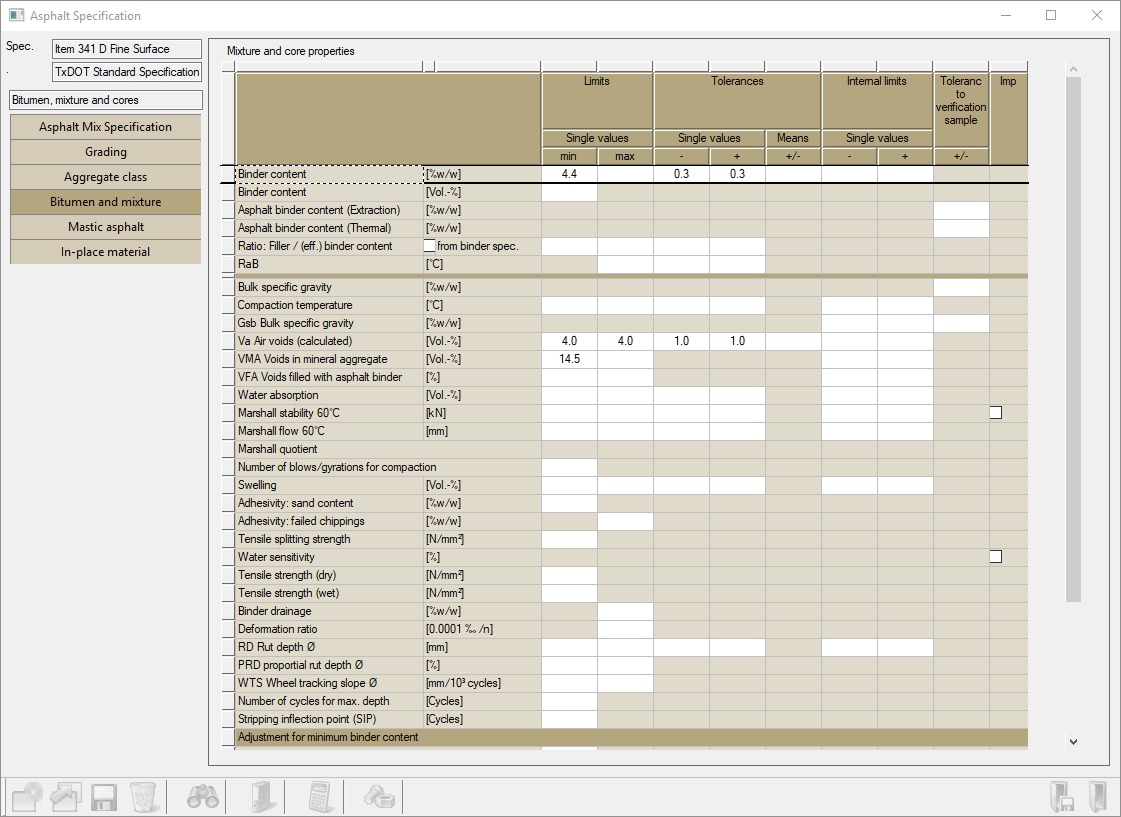
Plant settings and tracking of plant settings is the third key element to a declaration. The declaration stores the original mix design targets (called a recipe) and blend, which bring together plant settings and current feed aggregate properties based on the aggregate receiving inspection. Aggregate receiving inspection in the Asphalt Production Module allows users to quickly document aggregate properties just prior to addition into the plant, while calculating new plant settings (blends), providing a quick process for calculating precise plant adjustments.
The Blend Calculator built into the blend management system of LASTRADA is used to estimate the impact on gradation of possible feeder adjustments. In 2019, LASTRADA will incorporate an estimate of plant breakdown in blend management.
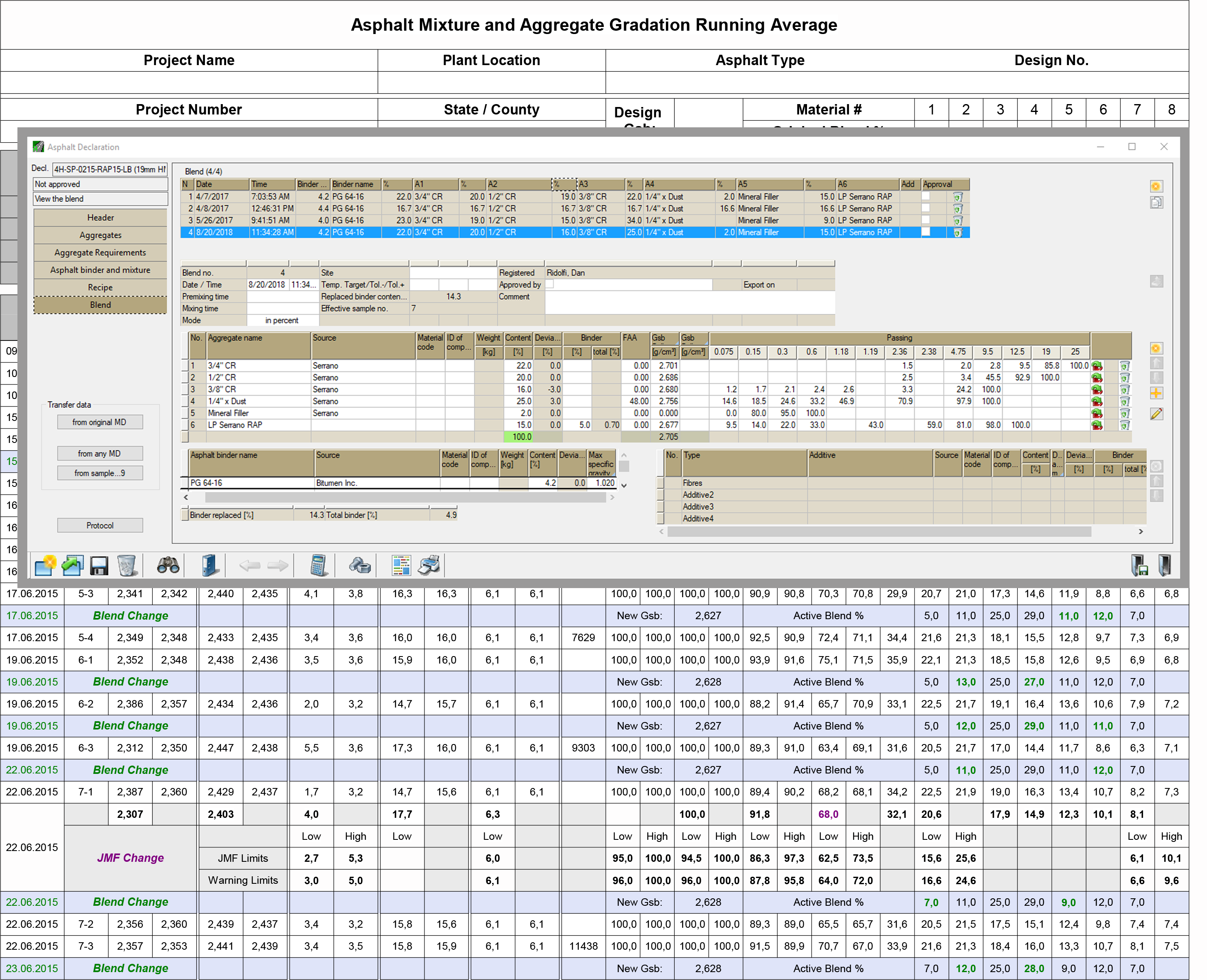
Asphalt Project Module
The Asphalt Project Module is designed for testing or engineering laboratories to measure the quality of asphalt produced in one or multiple plants. A number of tests are included in the Asphalt Project Module and can be reviewed here. Companies that sample test and report asphalt test results, both in the laboratory and in the field, use the Asphalt Project Module.
The Asphalt Project Module is commonly used in concert with the Laboratory Workflow Management Module. The Laboratory Workflow Management Module can register samples, create work requests, track progress, track review of results, track delivery of reports, and track completion of billing.
Asphalt Production Module
The Asphalt Production Module is designed with asphalt producers and plants in mind. It includes all the features and functions of the Asphalt Project Module along with a detailed statistics module with the LASTRADA exclusive key performance indicator (KPI) dashboard.
As with all reports in LASTRADA, statistics reports in the Asphalt Production Module are built on the LASTRADA Report Builder platform and can be modified to fit the exact needs of any customer. The statistics templates include tabular data, summary data (mean, standard deviation) and customizable control charts.
At its core, the KPI dashboard in the Asphalt Production Module is a process tool. The Performance Snapshot gives LASTRADA users a simple and easy-to-read diagram that describes a product’s likelihood of being within specification.
The KPI dashboard includes Six Sigma measures, which describe a processes’ ability to be within specification and whether that process is aligned with its associated specifications. The inclusion of the process control measure cumulative sum (CUSUM) in the KPI dashboard is unique to LASTRADA and describes the consistency of a process relative to itself. CUSUM identifies and flags process changes BEFORE failures occur.
LASTRADA is delivered with a simple KPI dashboard configuration allowing the user to begin focusing primarily on the Performance Snapshot and simple statistics. As a user’s database grows, LASTRADA Partners helps customers gain a deeper understanding of factors leading to success and assists in the creation of KPI dashboards for different LASTRADA users within the organization in order to present each user with the specific information they need to make the best quality decisions.
The Asphalt Production Module allows users to track properties of aggregates conveyed or delivered to their plant through what is called aggregate receiving inspection. Users of the LASTRADA Aggregate Production Module have the option to receive aggregate properties directly from the Aggregate Production Module or use aggregate receiving as a place to keep separate measured feeder gradations used to calculate blend adjustments.
LASTRADA users not using the Aggregate QC module or purchasing aggregates from a third-party use receiving inspection to declare the quality of individual aggregates for blend adjustment calculation or document the quality of delivered aggregates respectively. The received aggregate properties are the properties that best represent aggregates just prior to use by a plant.
When making blend adjustments, the receiving inspection properties of aggregates can be used to estimate the effect of a blend adjustment, which provides the production and quality staff with the best available product properties for their blend change calculation in the LASTRADA blend calculator.
The common use of receiving inspection is to monitor properties of aggregates delivered to a plant and or to periodically check feeder gradations or hot bin gradations. Long term, sophisticated LASTRADA users sometimes create multiple aggregate receiving declarations to compare and control aggregate quality at multiple locations in their asphalt production process.
Receiving inspection of asphalt binders is also supported in LASTRADA. Asphalt producers are able to sample and test liquid asphalt binder deliveries and assign those tests to asphalt binder declarations. Those tests and their declared values are available for analysis with all asphalt products that use that particular binder supply.v
Asphalt Mix Design Module
The Asphalt Mix Design Module brings together information from the Aggregate Production Module, Asphalt Production Module, Asphalt Binder Quality Control Module or Asphalt Binder Receiving Module, asphalt specifications, and other master data into a powerful design tool.
The Mix Design Module queries aggregate properties, recycled aggregate properties, and binder properties documented in their respective declarations. A designer can develop multiple trial blends and multiple trial mixes at one or more asphalt contents for that a blend. LASTRADA Partners has developed a summary tool that uses properties of one-point trials and estimates using Asphalt Institute published equations and optimum asphalt content with air voids and voids in mineral aggregate for each trial and presents the results in a one-page summary. That one-page summary is used to compare multiple blends and select the final blend for complete design.
Once the blend is selected, performance testing is completed, and the design is complete, the data can be locked, if desired.
LASTRADA is used in multiple states in the U.S., so a simple drop-down menu shows the state in which a mix design is provided. When applicable, changing the state can automatically adjust volumetric calculations, rounding of results, or other subtle yet difficult to manage state nuances.
The last step is to create an Asphalt Product Declaration and assign a mix design to a plant. If a mix design can be used in multiple states, the user simply changes the state selection in the dropdown from that of the mix design, and LASTRADA automatically adjusts to ensure proper calculation and rounding is used.
Documents that have been given clearance are digitally signed and automatically printed or sent, so documentation liabilities are no longer an issue.
Download all of this information in one easily searchable and sharable PDF document
Asphalt Binder Modules – LASTRADA™: Construction Materials Testing Software
Two asphalt binder modules are available for LASTRADA users: The Asphalt Binder Testing Module is designed for the testing of neat asphalt binders, modified asphalt binders, and emulsions. The Asphalt Binder Recipe Module helps terminals keep track of binder blends. Both the Asphalt Binder Production Module and the Asphalt Binder Recipe Module are built on the concept of an asphalt binder product declaration.
Asphalt Binder Product Declarations
LASTRADA is the only quality control software that uses a concept called a declaration to organize quality data in many LASTRADA modules. The Asphalt Binder Declaration has the following benefits:
- Ease of creating and tracking submittals on a project
- Easy reporting of testing reports or summaries by project
- Keeps product formulas organized
Although the concept of a declaration, in the form of an environmental product declaration, is now starting to be applied in the construction materials testing industry, the concept has been part of LASTRADA for over a decade. As a result, industry environmental product declaration tools like the one used by NAPA can receive data directly from LASTRADA’s Asphalt Mix Design Module.
An Asphalt Declaration brings together a plant or terminal, a specification, and recipe. A binder recipe can be developed in LASTRADA’s Asphalt Binder Recipes Module LASTRADA’s Asphalt Binder Declaration includes support for customers producing rubberized asphalt binder.
LASTRADA asphalt binder specifications include support for neat asphalt binders, modified asphalt binders, cationic emulsified asphalt binder and emulsified binders.
Asphalt Binder Testing Module
Users of the Asphalt Binder Testing Module have the option to directly enter results from their equipment like the dynamic shear rheometer, or they can use LASTRADA to calculate properties from individual measurements. LASTRADA has the ability to both determine if a binder complies with the binder complex shear modulus (G*/(sinδ)) specification or report the, “true grade”. The true grade is the temperature at which the minimum complex shear modulus is achieved.
Users will find all standard tests for evaluating neat asphalt binders, modified asphalt binders and emulsified asphalt binders are available in the Asphalt Binder Testing Module.
Asphalt Binder Recipes Module
The LASTRADA Asphalt Binder Recipes Module helps a terminal keep track of binder blends. The user defines components and percentages used to produce a liquid binder. The LASTRADA Report Builder is used to communicate the blend percentages into measurable quantities like, gallons, totes, tones, bags, etc. for the individuals manufacturing the binder products. LASTRADA has the ability to convert recipes into batch blend or in-line blend quantities.
View more information about using the Asphalt Binder Modules.
Download all of this information in one easily searchable and sharable PDF document
Aggregate Modules – LASTRADA™: Construction Materials Testing Software
Two asphalt binder modules are available for LASTRADA users: The Asphalt Binder Testing Module is designed for the testing of neat asphalt binders, modified asphalt binders, and emulsions. The Asphalt Binder Recipe Module helps terminals keep track of binder blends. Both the Asphalt Binder Production Module and the Asphalt Binder Recipe Module are built on the concept of an asphalt binder product declaration.
Aggregate Product Declarations
LASTRADA uses a proprietary concept called a product declaration to organize quality data in many LASTRADA modules. An aggregate declaration brings together plant settings and a product specification, which combines production specifications with owner specifications. The aggregate declaration is essentially the properties of a stockpile. The Aggregate Product Declaration has the following benefits:
- Ease of creating and tracking submittals on a project
- Ease of creating and tracking properties of bulk shipments of materials by barge or rail
- Ease of tracking material in unique stockpiles
- Ease of tracking impact of different aggregate plant modes
- Assignment of aggregate stockpiles to asphalt plants
- Tracking of plant settings for blended products
- Easy reporting of testing reports or summaries by project
In LASTRADA, perspective matters. Data entry or data review is organized and presented in multiple ways, to provide the right amount of information to each person using LASTRADA. For example, data entry can be accomplished via the Laboratory Workflow Management Module utilized by central laboratories and consultants, or by products produced by a plant and groups of products produced simultaneously from a plant. This concept of perspective is woven throughout LASTRADA, especially in the aggregates modules.
The Aggregate and Soil Project Module and the Aggregate Production Module are available for users of LASTRADA.
Aggregate and Soil Project Module
LASTRADA’s Aggregate and Soil Project Module includes the tests commonly used to measure or assess the quality of an aggregate or soil product. The list of available LASTRADA tests can be found here. This construction materials testing module supports multiple aggregate and soil specifications, plants, products, projects, and clients in a way that testing can be easily assigned to any of these items, while not losing the powerful relationships between them all.
The Aggregate and Soil Project Module can work as a standalone module for testing concrete, asphalt, base aggregates, and other rock products like rip rap and rail ballast. The Laboratory Workflow Management Module can be used to organize work in the Aggregate and Soil Project Module. If the lab chooses not to use the Laboratory Workflow Management Module, the Aggregate and Soil Project Module can be used as a standalone module.v
Engineers or managers can pre-define testing programs for samples through either laboratory workflow (testing labs) or product lists (aggregate plants). Technicians get immediate feedback of compliance with specifications or production tolerances with the sample status indicator. The status indicator also acts as a launching point to the Non-Compliance Reporting Module when people need to be notified of a failure and the issues need to be documented.
Soil has its own module within the Aggregate and Soil Module. The soil module data entry structures data around how quality control of mass grading operations are performed. Proctors, in place density measures, boring logs and other soil properties are quarriable by sample, by sampling location, or by soil type. Cross referencing any one or combination of these properties allows users to quickly determine compliance or properties of a location.
LASTRADA allows users to capture third party lab data or quality assurance data by keying in results directly when calculations are provided from an outside laboratory. Flags on these outside test results allow for side-by-side reporting and comparison of data when needed.
The LASTRADA Report Builder platform is used in the Aggregate and Soil Project Module. Users can use one of our pre-made reports or customize their own. This allows LASTRADA users to meet the demands of any client without the need for outside product support. Multiple samples can be loaded into their own individual reports to summarize a project.
Aggregate Production Module
The Aggregate Production Module adds process control features to the project module, making it ideal for aggregate producers.
Aggregate products in LASTRADA Aggregate Production Module are organized by how the plant is configured, called product lists. The products to be sampled, the sample locations, the test requested for each sample, and reporting template to be used can all be individual set and based on how a plant is running. This give LASTRADA users the ability to look at how the plant configuration affects aggregate quality of each product.
As with all reports in LASTRADA, statistics reports in the Aggregate Production Module are built on the LASTRADA report platform (link) and can be modified to fit exactly the needs for any customer. The statistics templates include tabular data, summary data (mean, standard deviation) and customizable control charts.
LASTRADA performs statistical analysis on an entire product list with one click. Most LASTRADA users typically use a summary by-product with graphs and tables combined into a single-page report.
LASTRADA’s aggregate production specifications include oversize/undersize criteria. Focusing on an aggregate product’s oversize helps producers identify when screening media is worn out. Managing undersized helps a producer understand changes in, “carry over” due to changes in screening efficiency.
The KPI dashboard in the Aggregate Production Module is at its core a process tool. The Performance Snapshot gives LASTRADA users a simple easy to read diagram that describes an aggregate’s likelihood of being within specification.
Six sigma measures control (link to Wikipedia 6 sigma) that describe a processed ability to be within specification and aligned with specifications are included. Unique to LASTRADA is the inclusion of the process control measure CUSUM cumulative sum (link to Wikipedia on CUSUM) which describes the consistency of a process relative to itself. CUSUM identifies and flags process changes, BEFORE failures occur.
LASTRADA Partners delivers LASTRADA with a simple KPI dashboard configuration to begin focusing primarily on the Performance Snapshot and simple statistics. As a customer’s database grows LASTRADA Partners will help customers gain a deeper understanding of factors leading to success and create one or more KPI dashboards for different LASTRADA users which present each user the information they need, no more, to make the best quality decisions.
Download all of this information in one easily searchable and sharable PDF document
Concrete Modules – LASTRADA™: Construction Materials Testing Software
Portland Cement Concrete Modules
LASTRADA has two very different modules for concrete construction materials testing laboratories and concrete producers. Both modules manage plastic and hardened concrete properties in the form of tests and specifications. Concrete products are defined by their target specification and the recipes used to achieve the specified concrete properties.
Concrete Project Module
The Concrete Project Module is designed to measure the quality of concrete produced in one or multiple plants. Concrete fresh properties are tested in the field and recorded into LASTRADA. Samples that are fabricated in the field are assigned ages and break dates with one or two clicks. The location of hardened concrete samples within a fog room or which a particular stock tank is added to LASTRADA making finding samples on testing dates easier.
LASTRADA’s reporting platform is used to generate paper reports for data capture and then entry in LASTRADA. LASTRADA also provides a grid entry if technicians want to enter their data directly into LASTRADA as they test samples. Advanced users directly transfer data from break machines into LASTRADA.
The Concrete Project Module is commonly used in concert with the Laboratory Workflow Management Module. The Laboratory Workflow Management Module registers samples, creates work requests, tracks progress, tracks review of results, track reporting, and billing.
Concrete Production Module
The Concrete Production Module is designed with a producer in mind. The features of the Concrete Project Module are also available in the production module. The concrete product data structure of the production module adds recipe details to product. This additional detail in the Concrete Production Module helps a producer organize their mix designs submittals and associated test results both by product recipe and customer. This makes generating test results for customers simple to do but allows the producer to analyze all the various recipes of a product simultaneously.
This product/recipe structure in LASTRADA is the foundation of concrete optimization.
It is not uncommon for advanced LASTRADA users of the production module to integrate LASTRADA with batch control systems and inventory management systems, so the optimization is happening real time based on most current data.
As with all reports in LASTRADA, reports in the Concrete Production Module are built on the LASTRADA report platform and can be modified to fit exactly the needs for any customer. The statistics templates include tabular data, summary data (mean, standard deviation) and customizable control charts.
Concrete Mix Design Module
The Concrete Mix Design Module brings together information from the Aggregate Production Module, the Cement Quality Control Module, concrete specifications, and other master data into a powerful design tool.
Each concrete trial batch is created using component products defined in the LASTRADA system and proportioned into a one cubic yard batch. Water demand and other properties are calculated and reported to the designer along with the trial batch testing data. When final mix proportions are adjusted and decided upon, the product is available for use in other LASTRADA modules.
Download all of this information in one easily searchable and sharable PDF document
Testing Lab Modules – LASTRADA™: Construction Materials Testing Software
Laboratory Workflow Management Module
For a private construction materials testing laboratory or central laboratory of a large organization, the Laboratory Workflow Management Module organizes the testing into work orders matching the workflow of these organizations. The work in the Asphalt Project Module, the Aggregate and Soil Project Module, the Concrete Project Module, and Asphalt Binder Project Module can all be managed by the Laboratory Workflow Management Module. LASTRADA’s Laboratory Workflow Management Module utilizes the same data entry, calculation, and reports.
The Laboratory Workflow Management Module organizes work in the following steps:
- Log samples into a laboratory logbook. Print a sample label if desired.
- Assign samples from the logbook into testing programs with tests assigned. Print testing program if desired.
- Assign a specification, and/or asphalt job mix formula, and/or concrete mix design and/or binder specification to a sample. Print data sheets with sample details and specification for tests to be performed.
- Perform tests
- Review results
- Produce report and store copy in document management
- Send report to customer
The module shows the status of all these steps in the form of a status bar that lights green as each step in complete.
LASTRADA utilizes a digital signature to release reports for distribution. Documents that have been given clearance are digitally signed and automatically printed or sent, so documentation liabilities are no longer an issue.
Multiple views of testing programs are available to help laboratories schedule their work, communicate deadlines, report status of samples, assign work and complete work. The Laboratory Workflow Management Module will feel familiar to any construction materials testing laboratory.
Work completed in the Laboratory Workflow Management Module can be billed either through LASTRADA’s Financial Management Module or by third party accounting software.
Financial Management Module
The Financial Management Module helps laboratories track billing and payments for work performed in the Laboratory Workflow Module. This module is typically integrated with third party financial management systems.
Download all of this information in one easily searchable and sharable PDF document
Add-On Modules – LASTRADA™: Construction Materials Testing Software
Non-Compliance Reporting Module
The Non-Compliance Reporting Module serves two purposes. It first is the vehicle to quickly notify an organization by email that a quality issue has been encountered. It has the second benefit of taking a snapshot of the issue. So, producers can take a 30,000 foot view of their operation and look at all failures as a group. This allows them to identify global issues that need resolution.
Basic users log an issue with a non-compliance email with a single click of the button. They periodically look at the source of issues and try to resolve recurring issues. More advanced users will document who was notified and when. In addition, they can connect a retested sample to non-compliance, and can see if an issue was resolved. Advanced users will track escalation and investigative steps and final results of investigation.
The Non-Compliance Reporting Module also uses the Report Builder, so reports can be adjusted to meet nearly any need.
Automated Reporting Module
To help people to remember to send regular reports, LASTRADA provides the ability to automate reports for various purposes. The most common use is daily, weekly, or monthly summaries of production test data. The Automated Reporting Module can also be used to deliver project test reports when a project has unique requirements. This module utilizes LASTRADA’s reporting platform, so users are free to design and modify templates as needed. Users can meet internal and external customer needs with the use of this feature.
LASTRADA users can configure the Automated Reporting Module quickly and easily. First, users select the desired report built in the LASTRADA reporting platform. Then, users will establish a frequency and define distribution. When appropriate, the Automated Reporting Module will notify a staff member that an automated report is ready for distribution. The staff member has the option to review the report before the report is sent. That same staff member then initiates the distribution of the report.

